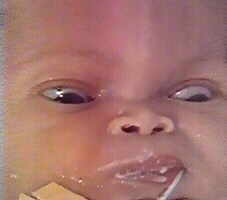What is Spina Bifida?
Spina bifida is an incomplete closure in the spinal column. In general, the three types of spina bifida (from mild to severe) are:

- Spina Bifida Occulta: There is an opening in one or more of the vertebrae (bones) of the spinal column without apparent damage to the spinal cord.
- Meningocele: The meninges, or protective covering around the spinal cord, has pushed out through the opening in the vertebrae in a sac called the “meningocele.” However, the spinal cord remains intact. This form can be repaired with little or no damage to the nerve pathways.
- Myelomeningocele: This is the most severe form of spina bifida, in which a portion of the spinal cord itself protrudes through the back. In some cases, sacs are covered with skin; in others, tissue and nerves are exposed. Generally, people use the terms “spina bifida” and “myelomeningocele” interchangeably.
Spina bifida is a chronic condition and there is no cure. It is important that the sac if protruding from the newborn be closed immediately because the risk of infection or meningitis is great.
Causes
No one knows what causes spina bifida. However, it has been linked to inadequate intake of folic acid by the mother during the first 4 weeks of her pregnancy. Also, taking Valproic Acid (this is used to treat seizures, bipolar disorder and to prevent migraines) during pregnancy may cause this condition.
Genetic factors may also be involved.
Characteristics of Spina Bifida
Children with the most serious form of spina bifida may have muscle weakness or complete paralysis below the area of the spine where the incomplete closure occurs, impaired sensation below the myelomeningeocele, and loss of bowel and bladder control. In addition, fluid may build up in the brain (a condition known as hydrocephalus). A large percentage of children born with myelomeningocele have hydrocephalus. Hydrocephalus may occur without spina bifida, but the two conditions often occur together.
Hydrocephalus (sometimes called water on the brain) causes the head to swell. Physical findings include very big head, big veins on the scalp, and eyes that are turned downward because of the pressure in the head (often known as setting sun sign).

A surgical operation to implant a ‘shunt‘ may need to be performed before the pressure of the liquid in the brain causes too much damage. When a shunt is inserted, a tube is run from a liquid-filled hollow in the brain to the entrance to the heart or into the belly (abdominal cavity). This allows the extra liquid to be drained from the brain. Not all children who have early signs of hydrocephalus need this operation. If the head is not very swollen and stops increasing rapidly in size, it may get better by itself.
If a child has a shunt, some common signs that it may not be working properly include:
- Vomiting
- Headaches
- Vision problems
- More tired than usual
- Easily upset
- Don’t feel right
Do not ignore these signs and refer the child to a neurologist or hospital immediately. This could cause the child’s death if the symptoms of a faulty shunt are ignored.
A shunt can stop working at any time if it:
- comes apart
- gets plugged up
- is too short
- falls apart
Problems that May Occur with Spina Bifida (not all children will have all of these problems)
Learning Problems – In some cases, children with spina bifida may have difficulty paying attention, expressing or understanding language, reading and math. Early intervention with children who experience learning problems can help considerably to prepare them for school. Successful integration of a child with spina bifida into school sometimes requires changes in school equipment or the curriculum.
Muscle Weakness – The trunk and legs of the child may exhibit muscle weakness or paralysis.
Contractures – Because of muscle weakness and muscle imbalance, children with spina bifida may develop contractures. These develop most often in the feet, hips and knees. Stretching and ROM (range of motion) exercises may assist in preventing these contractures. Lightweight, below-the-knee plastic braces may help the child to stand straighter.
Orthopedic Problems – One or both hips may be dislocated and the feet may turn down and in (club foot) or up and out.
Curvature of the Spine – Sometimes later in life, the child may develop a curvature of the spine.
Tethered Cord – Sometimes scar tissue forms following back surgery and attaches itself to the spinal cord and to nearby bone. During periods of growth, this may pull on the spinal chord. Symptoms of a tethered cord are: back pain, increased difficulty walking, scoliosis or curvature of the spine, and changes in bowel or bladder function.
Decreased Mobility Skills – Based on the level of the lesion on the spine, children with spina bifida have various abilities. Children with spina bifida need to learn mobility skills and often require the aid of crutches, braces or wheelchairs. To promote personal growth, families and teachers should encourage children (within the limits of safety and health) to be independent and to participate in activities with their classmates and peers.
Pressure Sores – Because the area below the lesion is often loses feeling, pressure sores on the buttocks and other areas of the skin may develop.
Foot Injuries – Children who walk but have no feeling may easily develop sores which can cause infections and foot deformities if left untreated.
Obesity (overweight) – Because the legs and feet of a child with spina bifida are weak, it is important that they do not grow too overweight, as this will make it harder for them to move.
Latex Allergies – Some children develop allergies to latex or natural rubber. Reactions can vary but may include itchy eyes, skin rash, coughing and sneezing.